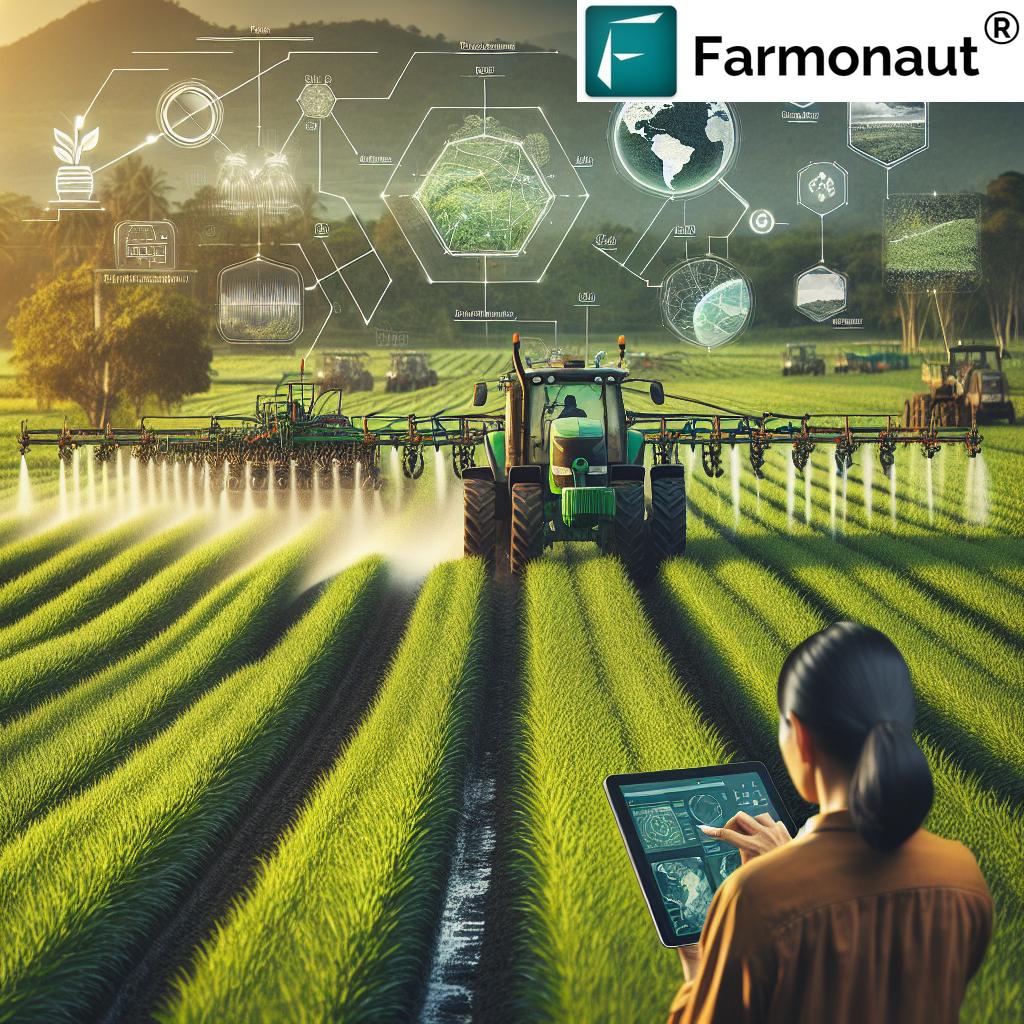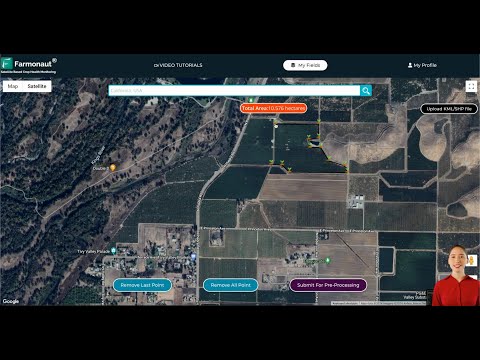Revolutionize Your Farm: Precision Agriculture and GIS Technology for Sustainable Crop Monitoring
“Precision agriculture can reduce water usage by up to 30% through advanced crop monitoring and irrigation management techniques.”

In today’s rapidly evolving agricultural landscape, farm safety best practices and agricultural risk management have become paramount for sustainable and efficient farming. At Farmonaut, we’re committed to revolutionizing the way farmers approach crop monitoring and farm management through cutting-edge precision agriculture technology. Our mission is to make these advanced tools accessible to farmers worldwide, ensuring that farms of all sizes can benefit from the latest innovations in agricultural technology.
In this comprehensive guide, we’ll explore how precision agriculture and GIS technology are transforming farm safety, crop monitoring solutions, and sustainable farming techniques. We’ll delve into the intersection of traditional farming wisdom and modern technological advancements, offering insights that can help both seasoned farmers and newcomers to agriculture create safer, more productive, and environmentally friendly farm environments.
The Evolution of Farm Safety through Precision Agriculture
As we venture into the realm of modern farming, it’s crucial to understand how precision agriculture is reshaping farm safety practices. Traditional farming methods, while time-tested, often come with inherent risks and inefficiencies. Precision agriculture, on the other hand, offers a data-driven approach that not only enhances productivity but also significantly improves farm safety.
- Enhanced Machinery Safety: Precision agriculture technologies, such as GPS-guided tractors and automated equipment, reduce the risk of accidents by minimizing human error in machinery operation.
- Improved Chemical Application: With precise crop monitoring and targeted application of pesticides and fertilizers, farmers can reduce exposure to harmful chemicals, enhancing both personal safety and environmental protection.
- Real-time Monitoring: Advanced sensors and IoT devices allow for continuous monitoring of farm conditions, alerting farmers to potential hazards before they escalate into dangerous situations.
By integrating these technologies, we at Farmonaut are helping farmers create safer working environments while optimizing their agricultural practices.
GIS Technology: A Game-Changer in Agricultural Risk Management
Geographic Information Systems (GIS) have emerged as a powerful tool in agricultural risk management. These systems allow farmers to visualize, analyze, and interpret data to understand patterns and relationships in their agricultural landscapes.
- Terrain Analysis: GIS helps identify areas prone to erosion or flooding, allowing farmers to implement preventive measures and plan safer field operations.
- Resource Allocation: By mapping out resources such as water sources and soil types, GIS aids in optimizing resource use and reducing the risks associated with overexploitation.
- Disease and Pest Management: GIS enables the creation of risk maps for crop diseases and pests, facilitating targeted interventions and reducing the need for broad-spectrum pesticide applications.
At Farmonaut, we harness the power of GIS to provide farmers with comprehensive insights into their land, empowering them to make informed decisions that mitigate risks and enhance farm safety.

Crop Monitoring Solutions: The Foundation of Sustainable Farming
Effective crop monitoring is at the heart of sustainable farming practices. With the advent of remote sensing technologies and satellite imagery, farmers now have unprecedented access to detailed information about their crops’ health and development.
- Satellite-Based Monitoring: Our satellite-based crop health monitoring system at Farmonaut provides real-time insights into vegetation health, soil moisture levels, and other critical metrics.
- Early Detection of Issues: By continuously monitoring crop health, farmers can identify and address problems such as pest infestations or nutrient deficiencies before they become severe.
- Optimized Resource Use: Precise monitoring allows for targeted application of water, fertilizers, and pesticides, reducing waste and minimizing environmental impact.
These crop monitoring solutions not only contribute to farm safety by reducing the need for manual inspections but also play a crucial role in implementing sustainable farming techniques.
Sustainable Farming Techniques Enabled by Technology
The integration of precision agriculture and GIS technology has paved the way for more sustainable farming practices. These techniques not only benefit the environment but also contribute to long-term farm viability and safety.
- Precision Irrigation: Using soil moisture sensors and weather data, farmers can apply water precisely where and when it’s needed, conserving this precious resource.
- Variable Rate Technology (VRT): VRT allows for the application of inputs like fertilizers at varying rates across a field, optimizing nutrient use and reducing runoff.
- Conservation Tillage: GIS and precision agriculture tools help farmers implement conservation tillage practices, reducing soil erosion and improving soil health.
By adopting these sustainable farming techniques, farmers can reduce their environmental footprint while also creating safer working conditions and more resilient agricultural systems.
Farm Machinery Safety in the Age of Precision Agriculture
Farm machinery safety remains a critical concern in agriculture. However, precision agriculture technologies are revolutionizing how we approach machinery operation and maintenance.
- Automated Guidance Systems: GPS-guided tractors and implements reduce operator fatigue and minimize the risk of accidents, especially during long working hours.
- Predictive Maintenance: IoT sensors on farm equipment can predict potential failures before they occur, preventing dangerous breakdowns in the field.
- Safety Training through VR: Virtual Reality (VR) simulations are being used to train operators on complex machinery without the risks associated with hands-on training on actual equipment.
At Farmonaut, we recognize the importance of integrating these safety features into our precision agriculture solutions, ensuring that technological advancements go hand-in-hand with improved farm safety.
Agricultural GIS Applications: Beyond Crop Monitoring
While crop monitoring is a primary application of GIS in agriculture, its uses extend far beyond this crucial function. GIS applications are transforming various aspects of farm management and safety.
- Livestock Management: GIS helps in tracking animal movements, optimizing grazing patterns, and managing herd health, contributing to safer and more efficient livestock handling.
- Transport Safety: Route optimization for farm vehicles reduces travel time and fuel consumption while also minimizing the risk of accidents on rural roads.
- Emergency Response: In case of farm accidents or natural disasters, GIS can provide critical information to emergency responders, potentially saving lives.
These diverse applications of GIS in agriculture demonstrate its potential to create comprehensive safety solutions for farms of all types and sizes.
“GIS technology in agriculture can increase crop yields by 10-15% by optimizing resource allocation and field management strategies.”
Remote Sensing in Agriculture: Enhancing Crop Health and Safety
Remote sensing technologies have become indispensable tools in modern agriculture, offering farmers unprecedented insights into their crops and land.
- Multispectral Imaging: This technology allows for the detection of crop stress, diseases, and nutrient deficiencies before they’re visible to the naked eye.
- Thermal Imaging: Useful for detecting irrigation issues and assessing crop water stress, helping farmers manage water resources more effectively.
- LIDAR Technology: Light Detection and Ranging (LIDAR) can create detailed 3D maps of farmland, aiding in precision planting and identifying areas prone to erosion or flooding.
By leveraging these remote sensing technologies, we at Farmonaut provide farmers with the tools they need to monitor crop health safely and efficiently, reducing the need for potentially hazardous manual inspections.
Farm Management Software: Streamlining Operations for Enhanced Safety
Effective farm management is crucial for maintaining a safe and productive agricultural environment. Farm management software integrates various aspects of farming operations, from crop planning to financial management, into a single, user-friendly platform.
- Task Scheduling and Reminders: Ensures that critical safety checks and maintenance tasks are never overlooked.
- Inventory Management: Keeps track of chemicals, fuels, and other potentially hazardous materials, reducing the risk of accidents due to mishandling.
- Compliance Tracking: Helps farmers stay up-to-date with safety regulations and best practices, ensuring a safer working environment.
Our farm management software at Farmonaut is designed to integrate seamlessly with our precision agriculture and GIS solutions, providing a comprehensive tool for safe and efficient farm operations.
Soil Health Monitoring: The Foundation of Sustainable Agriculture
Soil health is fundamental to sustainable agriculture and farm safety. Precision agriculture technologies offer advanced methods for monitoring and maintaining soil health.
- Soil Sensors: In-field sensors provide real-time data on soil moisture, temperature, and nutrient levels, allowing for precise management of soil resources.
- Spectral Analysis: Remote sensing techniques can assess soil organic matter content and other key indicators of soil health across large areas.
- Microbial Activity Monitoring: Advanced techniques are being developed to monitor soil microbial activity, a key indicator of overall soil health.
By focusing on soil health, farmers can reduce the need for chemical inputs, improve water retention, and create a more resilient farming system that’s safer for both workers and the environment.
Implementing Farm Safety Best Practices with Technology
While technology plays a crucial role in enhancing farm safety, it’s essential to combine these advancements with traditional safety best practices. Here’s how precision agriculture and GIS can support the implementation of key safety measures:
- Personal Protective Equipment (PPE) Tracking: Use RFID tags to track PPE usage and ensure workers are properly equipped for their tasks.
- Weather Monitoring: Integrate real-time weather data into farm management systems to alert workers of potentially dangerous conditions.
- Training and Education: Utilize augmented reality (AR) and virtual reality (VR) technologies to provide immersive safety training experiences.
At Farmonaut, we believe that the most effective approach to farm safety combines cutting-edge technology with time-tested safety protocols.
The Future of Agricultural Risk Management
As we look to the future, the role of technology in agricultural risk management will only continue to grow. Emerging technologies and trends include:
- Artificial Intelligence (AI) and Machine Learning: These technologies will enable more accurate prediction of risks and automate many aspects of farm management.
- Blockchain for Traceability: Improving supply chain transparency and food safety through immutable record-keeping.
- Drone Technology: Expanding the capabilities of aerial surveying and precision application of inputs.
By staying at the forefront of these technological advancements, we at Farmonaut are committed to providing farmers with the most advanced tools for risk management and farm safety.
Conclusion: Embracing Technology for a Safer, More Sustainable Agricultural Future
As we’ve explored throughout this blog, the integration of precision agriculture and GIS technology is revolutionizing farm safety, crop monitoring, and sustainable farming practices. By embracing these technologies, farmers can create safer working environments, optimize resource use, and improve overall farm productivity.
At Farmonaut, we’re dedicated to making these advanced agricultural technologies accessible to farmers worldwide. Our comprehensive suite of tools, from satellite-based crop monitoring to AI-driven advisory systems, is designed to support farmers in their journey towards safer, more sustainable agriculture.
We invite you to join us in this agricultural revolution. Whether you’re a small-scale farmer or managing large agricultural operations, our solutions can be tailored to meet your specific needs. Together, we can cultivate a safer, more sustainable future for agriculture.
FAQs
- How does precision agriculture improve farm safety?
Precision agriculture enhances farm safety by reducing human exposure to hazardous conditions through automated machinery, precise application of chemicals, and real-time monitoring of farm conditions. - What are the key benefits of using GIS in agriculture?
GIS in agriculture offers benefits such as improved resource management, better decision-making through spatial analysis, and enhanced risk assessment and mitigation. - How can remote sensing help in crop health monitoring?
Remote sensing technologies provide early detection of crop stress, diseases, and nutrient deficiencies, allowing for timely interventions and reducing the need for potentially dangerous manual inspections. - What role does soil health monitoring play in sustainable farming?
Soil health monitoring is crucial for sustainable farming as it helps optimize nutrient management, improve water retention, and reduce the need for chemical inputs, leading to safer and more environmentally friendly farming practices. - How can farmers integrate precision agriculture technologies into their existing operations?
Farmers can start by adopting basic precision agriculture tools like GPS-guided machinery or satellite-based crop monitoring services, gradually expanding to more advanced technologies as they become familiar with the systems and see the benefits.
Farm Safety Best Practices Comparison
| Safety Aspect | Traditional Method | Precision Agriculture Approach | Safety Improvement (%) | Sustainability Impact |
|---|---|---|---|---|
| Crop Monitoring | Manual field inspections | Remote sensing and GIS-based monitoring | 60% | Reduced chemical usage, improved resource management |
| Machinery Operation | Manual operation | GPS-guided autonomous vehicles | 70% | Reduced fuel consumption, minimized soil compaction |
| Livestock Handling | Physical herding and manual checks | RFID tracking and automated health monitoring | 50% | Improved animal welfare, reduced stress on livestock |
| Chemical Application | Uniform application across fields | Variable rate technology for targeted application | 80% | Significant reduction in chemical use, less environmental impact |
| Soil Health Management | Periodic soil testing | Continuous soil sensors and spectral analysis | 65% | Enhanced soil conservation, reduced erosion |
Ready to revolutionize your farming practices with cutting-edge precision agriculture technology? Explore Farmonaut’s comprehensive solutions:
For developers interested in integrating our powerful agricultural data into their own applications, check out our API and API Developer Docs.
Download our mobile apps for on-the-go farm management:
Farmonaut Subscriptions




